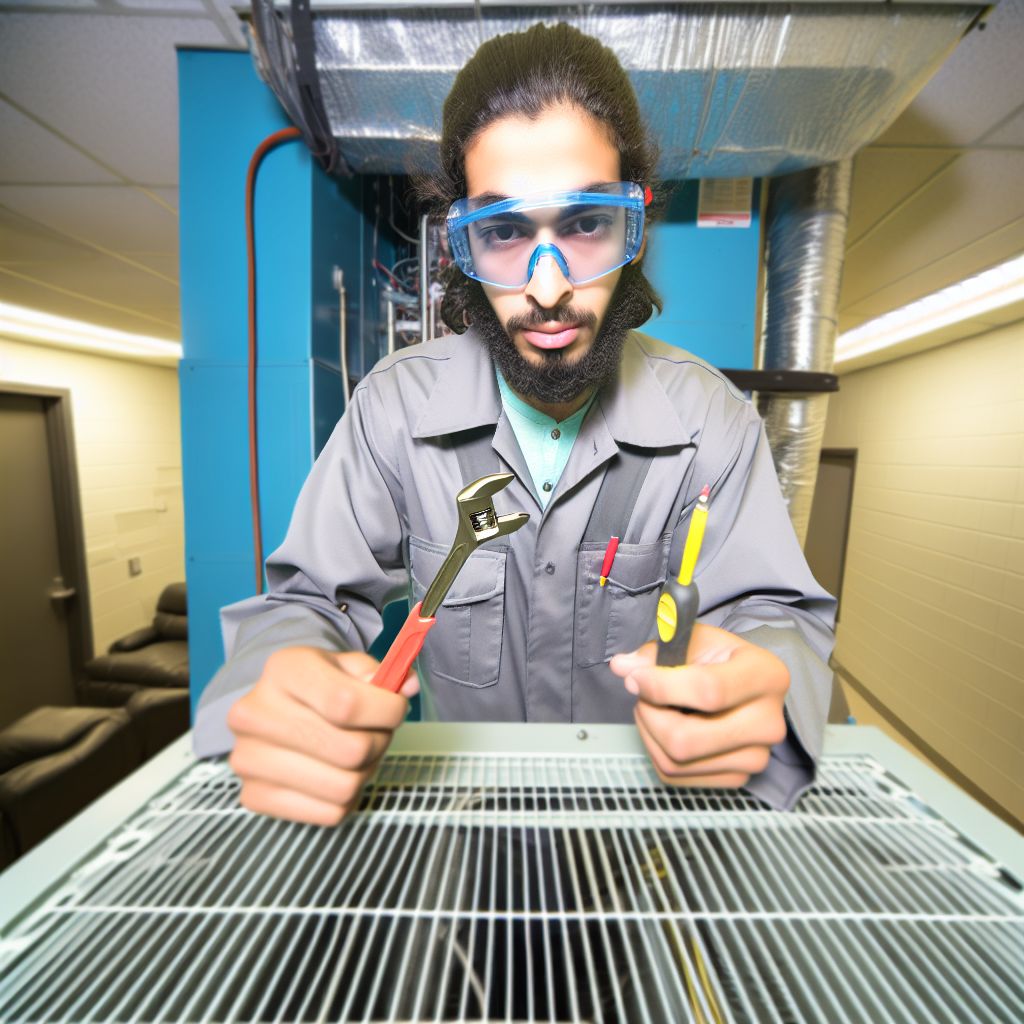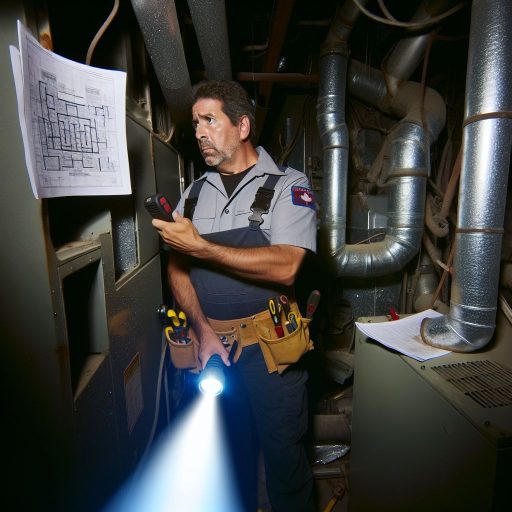Understanding the Fundamentals of HVAC Systems and Their Components
Overview of HVAC Systems
HVAC stands for heating, ventilation, and air conditioning.
These systems regulate air temperature and quality indoors.
They play a crucial role in maintaining comfort in residential and commercial spaces.
Components of HVAC Systems
HVAC systems consist of several key components.
Heating units generate warmth during colder months.
Cooling appliances provide relief during hot weather.
Ventilation systems ensure proper air circulation.
Each component works in harmony to enhance indoor air quality.
Heating Mechanisms
Heating can be achieved through various methods.
For instance, furnaces and boilers are common heating units.
Heat pumps offer an energy-efficient option for heating.
Electric heaters provide supplemental heat when needed.
Cooling Mechanisms
Air conditioning units are essential during summer months.
They lower indoor temperatures and dehumidify the air.
Split systems and central air conditioning are popular choices.
Regular maintenance of these units enhances their efficiency.
Ventilation Systems
Proper ventilation enhances air quality significantly.
It removes stale air and introduces fresh air from outdoors.
Natural ventilation relies on windows and vents for airflow.
Mechanical ventilation uses fans to enhance air movement.
Importance of Indoor Air Quality
Indoor air quality affects health and comfort levels.
Poor air quality can lead to respiratory issues and allergies.
HVAC technicians play a vital role in monitoring air quality.
They ensure systems operate efficiently to maintain cleanliness.
Regular Maintenance Practices
HVAC technicians perform routine inspections of systems.
Unlock Your Career Potential
Visualize a clear path to success with our tailored Career Consulting service. Personalized insights in just 1-3 days.
Get StartedThis includes checking filters, ducts, and components.
Regular maintenance promotes optimal performance and longevity.
Technicians often recommend filter replacements for better air quality.
Advanced Technology in HVAC Systems
Modern HVAC systems use advanced technology for efficiency.
Smart thermostats allow for precise temperature control.
Energy-efficient units reduce utility bills and environmental impact.
Technicians stay updated on innovations in HVAC technology.
The Role of HVAC Technicians in Maintaining Indoor Air Quality
Importance of Indoor Air Quality
Indoor air quality significantly affects health and comfort.
Poor air quality can lead to respiratory issues and allergies.
Thus, maintaining clean indoor air is essential for well-being.
Responsibilities of HVAC Technicians
HVAC technicians have crucial roles in ensuring good air quality.
First, they inspect and maintain HVAC systems regularly.
This prevents the buildup of dust and allergens in the air.
Moreover, they check air filters to ensure effective filtration.
Dirty filters restrict airflow and reduce air quality.
Implementation of Air Quality Standards
Technicians adhere to industry standards for air quality.
They conduct air quality assessments to identify issues.
These assessments clarify both indoor and outdoor air quality factors.
Furthermore, they implement necessary adjustments to systems.
Utilizing Advanced Technology
HVAC technicians employ modern technology to improve air quality.
For instance, they might recommend air purifiers or dehumidifiers.
These tools help remove pollutants and maintain proper humidity levels.
Additionally, sensors can detect harmful air particles.
These sensors alert technicians to emerging issues promptly.
Educating Clients About Air Quality
Technicians also educate clients on maintaining air quality.
They provide guidance on regular maintenance practices.
Proper maintenance extends the lifespan of HVAC systems.
Moreover, education on healthy indoor habits is crucial.
Clients learn about keeping spaces clean and ventilated.
Common Indoor Air Quality Issues and Their Sources
Understanding Common Issues
Indoor air quality problems often stem from various sources.
Pollutants can arise from both outdoor and indoor environments.
Common issues include dust, mold, and volatile organic compounds.
Sources of Dust Accumulation
Dust typically comes from everyday activities and materials in homes.
Furniture, carpets, and bedding can all contribute to dust buildup.
Additionally, outdoor sources such as soil and pollen can enter the home.
Mold Growth Factors
Mold thrives in areas with excess moisture and poor ventilation.
Bathrooms, kitchens, and basements are common mold hotspots.
Failure to promptly fix leaks can exacerbate mold issues.
Volatile Organic Compounds Explained
Volatile organic compounds, or VOCs, originate from household products.
Common sources include paints, cleaners, and building materials.
These compounds can evaporate into the air, affecting indoor quality.
Identifying Chemical Contaminants
Chemical contaminants may also arise from improper storage of materials.
For instance, pesticides and certain cleaning agents can pollute the air.
Poorly maintained HVAC systems can contribute to this problem.
The Role of HVAC Systems
HVAC systems can both mitigate and compound indoor air quality issues.
Regular maintenance ensures filters are clean and functioning properly.
Moreover, professional inspections can identify hidden problems.
Strategies for Maintaining Indoor Air Quality
Addressing these common indoor air quality issues is crucial.
Implementing preventive measures can create a healthier living environment.
Therefore, regular monitoring and maintenance are strongly recommended.
Uncover the Details: Tools Every Upholsterer Should Have in Their Toolbox
Techniques Used by HVAC Technicians to Assess Air Quality
Visual Inspections
HVAC technicians start with visual inspections of the heating and cooling equipment.
They look for visible dust buildup and potential blockages.
Next, they examine ductwork for possible leaks or other issues.
Air Quality Testing
Technicians often conduct air quality tests in residential or commercial spaces.
These tests measure the levels of pollutants and allergens in the air.
Using specialized equipment, they can detect carbon monoxide and volatile organic compounds.
Humidity Measurement
Humidity plays a significant role in indoor air quality.
Technicians measure humidity levels using hygrometers.
If humidity is too high, it can promote mold and mildew growth.
Conversely, low humidity can lead to dry skin and respiratory issues.
Filtration System Evaluation
Effective filtration systems are crucial for maintaining good air quality.
HVAC technicians assess the condition of air filters.
They check whether filters need to be replaced or cleaned.
Moreover, they evaluate the type of filters in use to ensure they meet specific air quality standards.
Ventilation Assessment
Proper ventilation ensures a continual supply of fresh air.
Technicians evaluate airflow in various rooms to identify any issues.
They also inspect exhaust systems to verify they are functioning correctly.
Good ventilation helps reduce indoor air pollutants significantly.
Client Education
Educating clients is an essential part of improving air quality.
Technicians explain the importance of regular maintenance.
They offer tips for better indoor air quality practices, such as using plants.
Lastly, technicians encourage homeowners to keep windows open when weather permits.
Uncover the Details: How to Build a Successful Bricklaying Business
Importance of Air Filtration in HVAC Systems
Air filtration plays a crucial role in maintaining indoor air quality.
It protects occupants from airborne pollutants and allergens.
Additionally, effective filtration improves HVAC system efficiency.
This leads to lower energy costs over time.
Moreover, well-maintained filters contribute to longer equipment lifespan.
Understanding Airborne Pollutants
Indoor air can contain a variety of pollutants.
Examples include dust, pollen, smoke, and pet dander.
These contaminants can exacerbate respiratory issues.
Consequently, effective filtration systems are essential.
Types of HVAC Filters
Various filters are available for HVAC systems.
Each type has unique properties and efficiency levels.
- Fiberglass filters are affordable but less effective.
- Pleated filters capture more particles and have a longer lifespan.
- HEPA filters are highly efficient for small particles.
- Washable filters can be reused, reducing waste.
Choosing the Right Filter
Selecting the appropriate filter is vital for optimal performance.
Consider the specific needs of your environment.
Higher efficiency filters may be necessary for allergy sufferers.
Understanding your HVAC system’s requirements will guide your choice.
Maintenance of Filters
Regular maintenance is key to effective air filtration.
Check and replace filters according to manufacturer recommendations.
This ensures continued airflow and system efficiency.
Additionally, schedule professional inspections annually.
Ultimately, proactive maintenance extends the life of your HVAC system.
Uncover the Details: Common Challenges Faced by Canadian Bricklayers

Regular Maintenance Practices That Enhance Indoor Air Quality
Importance of Regular Maintenance
Regular maintenance is crucial for ensuring good indoor air quality.
HVAC systems significantly impact the air you breathe inside your home.
Consistent upkeep helps eliminate harmful pollutants and allergens.
In addition, it promotes a comfortable living environment for everyone.
Filter Replacement
Regularly replacing air filters is a key maintenance practice.
Dirty filters can obstruct airflow and create dust buildup.
It is essential to replace filters every one to three months.
This simple task can dramatically improve air quality.
Cleaning Ductwork
Keeping ductwork clean is another vital step for indoor air quality.
Over time, dust and debris accumulate within the ducts.
Professionals recommend cleaning ducts every three to five years.
This action prevents contaminants from circulating through your home.
Inspecting and Cleaning Coils
Coils play a vital role in HVAC systems’ efficiency.
Cleansing the coils regularly improves air circulation.
Additionally, clean coils help maintain optimal system efficiency.
A professional can effectively perform this maintenance task.
Checking for Leaks
Identifying and repairing leaks can enhance system performance.
Leaks allow conditioned air to escape, affecting efficiency.
Moreover, they can introduce outside pollutants into your home.
Technicians use specialized tools to detect and seal these leaks.
Testing Indoor Air Quality
Technicians often conduct air quality tests during maintenance visits.
These tests measure levels of common pollutants.
Testing helps identify issues that may need addressing.
Moreover, it provides insights to improve air conditions overall.
Balancing the System
System balancing ensures consistent airflow throughout your home.
Imbalances can lead to specific areas experiencing poor air quality.
Technicians can adjust airflow to achieve optimal performance.
This practice enhances comfort and indoor air quality effectively.
You Might Also Like: Importance of Blueprint Reading in Metal Fabrication
Innovations in HVAC Technology for Air Quality Improvement
Advanced Filtration Systems
Advanced filtration systems significantly enhance indoor air quality.
These systems capture smaller particles effectively.
They also help in removing allergens and pollutants.
High-Efficiency Particulate Air (HEPA) filters are widely used.
Moreover, many systems now incorporate UV-C light technology.
This technology disinfects the air while reducing microbial growth.
Smart Thermostats and Sensors
Smart thermostats optimize energy use while enhancing air quality.
They adjust temperatures based on occupancy patterns.
This innovation also includes air quality sensors.
These sensors monitor levels of humidity, CO2, and VOCs.
Consequently, they provide real-time feedback to users.
Users can make informed decisions on indoor air management.
Variable Refrigerant Flow Systems
Variable Refrigerant Flow (VRF) systems offer flexible cooling options.
They adjust refrigerant flow based on specific needs.
These systems operate quietly and reduce energy consumption.
Most importantly, they maintain consistent humidity levels.
This helps prevent mold and mildew growth indoors.
Enhanced Ventilation Techniques
Innovative ventilation methods are vital for healthy indoor environments.
Demand-controlled ventilation adjusts airflow based on occupancy.
This strategy helps optimize energy efficiency as well.
Furthermore, heat recovery ventilators exchange stale air with fresh air.
This process reduces heating and cooling costs.
Integration with Smart Home Systems
HVAC systems increasingly integrate with smart home technologies.
Users can control their systems remotely via smartphone apps.
This feature increases user engagement and awareness of air quality.
Moreover, automation settings help maintain optimal conditions.
These systems can learn and adapt to individual preferences.
Best Practices for HVAC Installation that Promote Optimal IAQ
Choosing the Right Equipment
Select high-efficiency HVAC systems that enhance indoor air quality.
Pay attention to air filtration ratings when selecting equipment.
Consider systems with built-in humidifiers or dehumidifiers.
Opt for units that feature variable-speed fans for better airflow control.
Proper Sizing and Load Calculation
Accurate load calculations ensure the system meets the building’s needs.
Use software tools to perform detailed sizing calculations.
An undersized unit can struggle to maintain optimal indoor environments.
Conversely, oversized systems may cycle too frequently, affecting air quality.
Installation Techniques
Follow manufacturer guidelines for proper installation procedures.
Prioritize sealing all duct connections to prevent air leaks.
Insulate ducts to combat energy loss and enhance efficiency.
Install the system in a location that allows for effective airflow.
Regular Maintenance and Service
Schedule routine inspections for HVAC systems to maintain efficiency.
Change filters regularly to ensure optimal airflow and filtration.
Cleansing ducts can remove accumulated dust and allergens.
Consider professional maintenance at least twice a year.
Monitoring Indoor Air Quality
Incorporate air quality monitors to detect pollutants in real-time.
Educate building occupants on identifying signs of poor air quality.
Provide information on improving air quality through simple habits.
Encourage regular feedback from users regarding comfort levels.
Implementing Ventilation Strategies
Ensure adequate ventilation systems for fresh air circulation.
Use energy recovery ventilators to improve indoor air exchange.
Utilize exhaust fans in high-moisture areas like kitchens and bathrooms.
Balance intake and exhaust airflows to maintain comfort and air quality.
Additional Resources
plumber vs electrician vs hvac? : r/Plumbing
What is a better trade, HVAC technician or a welder? – Quora




